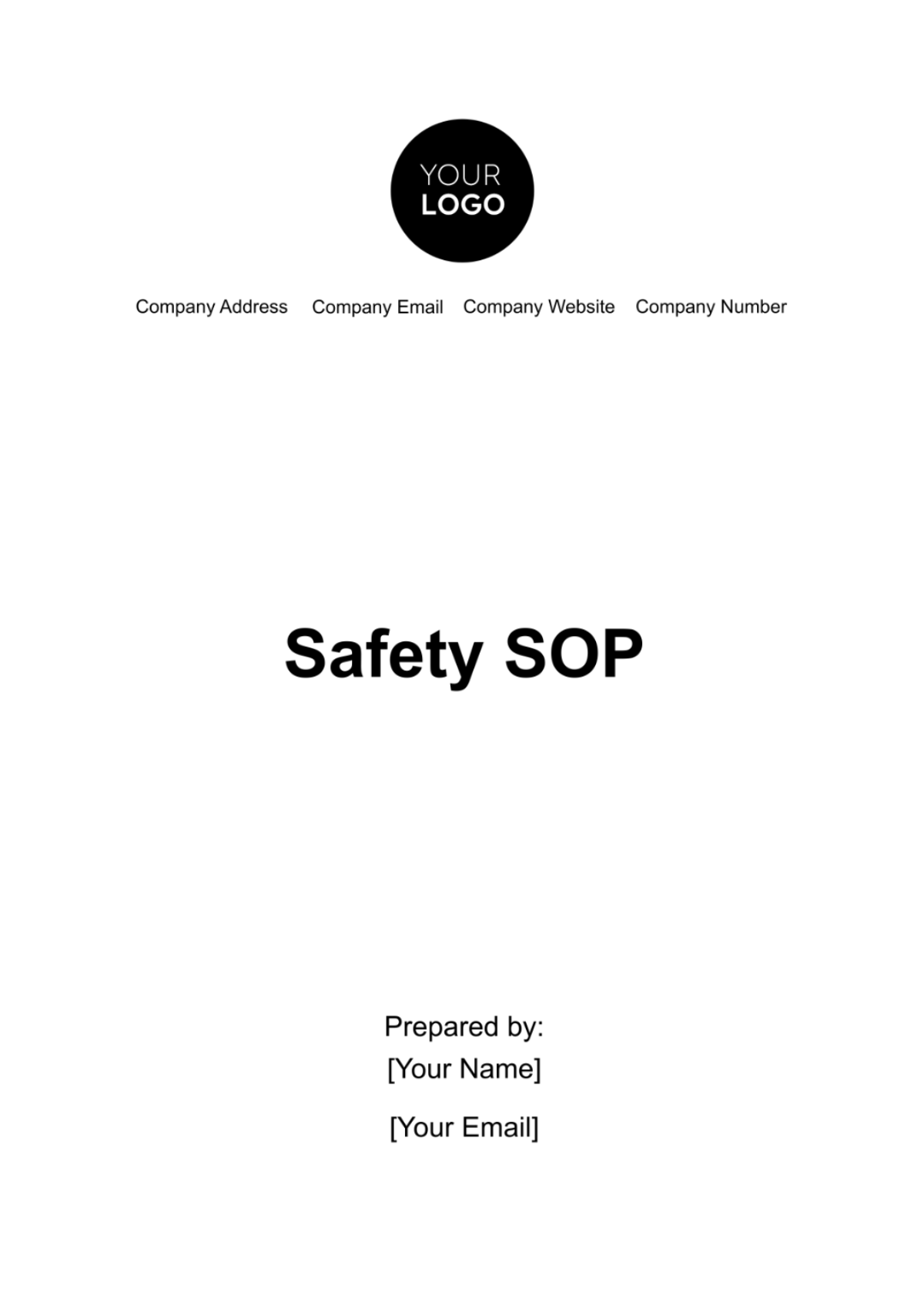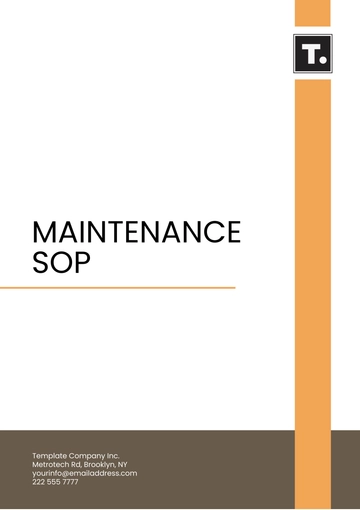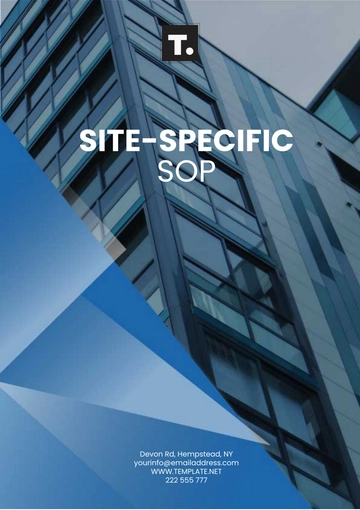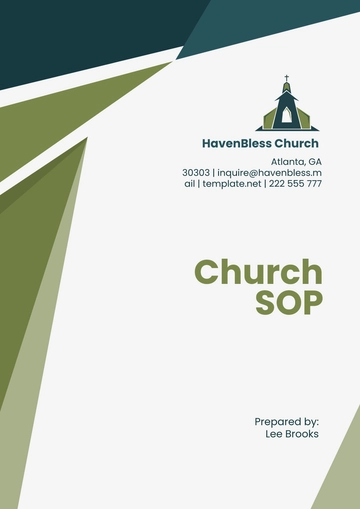Free Safety SOP

I. Introduction
A. Purpose
Our commitment to ensuring the health and safety of all employees drives the development of this Safety Standard Operating Procedure (SOP). This document serves as a comprehensive guide to safe work practices, designed to mitigate risks, prevent accidents, and create a secure working environment. The purpose of this SOP is to establish standardized procedures that align with regulatory requirements and industry best practices, ensuring a consistent and effective approach to workplace health and safety.
B. Scope
This SOP applies to all employees, contractors, and visitors within our company. It encompasses all activities, operations, and processes conducted on company premises or under company supervision. The scope of this SOP extends to various departments and functions, emphasizing the uniform application of safety protocols throughout the company. Any deviations from this SOP must be approved by and communicated to relevant stakeholders.
II. Roles and Responsibilities
Ensuring the success of our safety initiatives requires a collective effort. The responsibilities outlined below designate specific roles within the company to oversee the implementation and enforcement of safety procedures:
A. Safety Officer/Committee
Oversee the overall implementation and effectiveness of safety protocols.
Review and approve any deviations from this SOP.
B. Department Heads
Ensure that employees within their departments are trained on and adhere to safety protocols.
Report any safety concerns or incidents promptly to the Safety Officer.
C. Employees
Follow safety protocols and procedures applicable to their tasks.
Report incidents, near misses, and hazards promptly to their supervisors or the Safety Officer.
III. Objectives
The objectives of this Safety SOP are aligned with our broader commitment to creating a safe and secure work environment. These objectives include:
A. Injury Prevention
Minimize the risk of workplace injuries through the implementation of proactive safety measures.
Promote a culture of safety awareness among employees.
B. Regulatory Compliance
Ensure compliance with local, state, and federal regulations pertaining to workplace health and safety.
Regularly update the SOP to reflect any changes in relevant legislation.
C. Emergency Preparedness
Establish clear procedures for responding to emergencies, including evacuation plans and communication protocols.
Conduct regular emergency drills to test the effectiveness of response strategies.
IV. Definitions
In our commitment to clarity and consistency, it is imperative to establish a common understanding of key terms and concepts used throughout this Safety SOP. The following term definitions are crucial for ensuring that all employees interpret and apply safety procedures uniformly:
A. Hazard
Any potential source of harm, damage, or adverse health effects. Hazards can be categorized as physical, chemical, biological, ergonomic, or psychosocial.
B. Risk
The likelihood and severity of harm arising from a hazard. Risk is often assessed using a risk matrix, considering the probability of an event occurring and its potential consequences.
C. Personal Protective Equipment (PPE)
Equipment and clothing worn to minimize exposure to occupational hazards. Examples include safety helmets, gloves, eye protection, and respiratory protection.
D. Emergency
A sudden and unforeseen situation requiring immediate action. Emergencies can include fires, chemical spills, medical incidents, or natural disasters.
E. Near Miss
An unplanned event that did not result in injury or damage but had the potential to do so. Near misses provide valuable opportunities for learning and prevention.
V. Regulatory Framework
Our commitment to workplace health and safety encompasses a proactive engagement with and understanding of the regulatory framework that governs our operations. By aligning our safety protocols with relevant laws, regulations, and industry standards, we not only meet legal requirements but also elevate our commitment to providing a secure work environment which is outlined below:
A. Occupational Safety and Health Administration (OSHA)
The Occupational Safety and Health Administration (OSHA) stands as the cornerstone of workplace safety regulations in the United States. Complying with OSHA standards is not just a legal obligation but a commitment to upholding the highest standards of safety. Regular updates and communication channels ensure that our safety protocols evolve in tandem with any changes in OSHA regulations.
B. State Health and Safety Legislation
In addition to OSHA regulations, we adhere to the specific health and safety legislation governing our geographical location. This comprehensive approach ensures that our safety practices are tailored to the unique regulatory landscape of our operating environment.
C. Industry Standards
These standards, established by reputable professional associations or certification bodies, serve as benchmarks for best practices in safety. Regular reviews and assessments ensure that our safety protocols not only meet but often surpass these industry benchmarks.
D. Company Policies and Procedures
While external regulations set the baseline, our company goes above and beyond by establishing internal policies and procedures. These go hand in hand with legal requirements, providing an additional layer of protection and assurance for our employees. Our internal policies reflect our commitment to continuous improvement and the pursuit of excellence in workplace safety.
E. Continuous Monitoring and Adaptation
Regulatory landscapes are dynamic, and staying abreast of changes is crucial. Our commitment to continuous improvement includes monitoring regulatory updates, conducting regular assessments, and adapting our safety protocols accordingly. This proactive approach ensures that our safety standards remain not only compliant but also cutting-edge in an ever-evolving environment.
VI. Risk Assessment
Risk assessment forms the bedrock of our safety initiatives, providing a systematic approach to identify, evaluate, and mitigate potential hazards within our work environment. By comprehensively understanding the risks associated with our operations, we empower our workforce to proactively contribute to a safer workplace.
A. Risk Identification
1. Methodology
Our risk identification process involves regular assessments conducted by designated safety officers. These assessments encompass a thorough examination of work areas, processes, and equipment. Employees are also encouraged to report potential hazards through our robust reporting system.
2. Employee Involvement
Recognizing that employees are often closest to the operational aspects of their roles, we actively involve them in the risk identification process. Regular safety meetings and open communication channels foster an environment where employees feel empowered to contribute insights on potential hazards.
B. Risk Evaluation
1. Risk Matrix
Utilizing a risk matrix, we assess the likelihood and severity of identified risks. This matrix categorizes risks into different levels, enabling us to prioritize mitigation efforts. This structured approach ensures that resources are allocated efficiently to address the most critical risks first.
Likelihood/Severity | Low | Medium | High |
Low | L-L | L-M | L-H |
Medium | M-L | M-M | M-H |
High | H-L | H-M | H-H |
1.1. Likelihood
The probability of an event occurring, categorized as Low, Medium, or High.
1.2. Severity
The potential impact or consequence of the event, categorized as Low, Medium, or High.
1.3. Risk Levels
L-L (Low-Low): Low likelihood and low severity.
L-M (Low-Medium): Low likelihood and medium severity.
L-H (Low-High): Low likelihood and high severity.
M-L (Medium-Low): Medium likelihood and low severity.
M-M (Medium-Medium): Medium likelihood and medium severity.
M-H (Medium-High): Medium likelihood and high severity.
H-L (High-Low): High likelihood and low severity.
H-M (High-Medium): High likelihood and medium severity.
H-H (High-High): High likelihood and high severity.
2. Continuous Monitoring
Risk evaluation is an ongoing process. As operational dynamics change, new risks may emerge. Continuous monitoring, feedback mechanisms, and periodic reassessments ensure that our risk evaluation remains dynamic and responsive to the evolving nature of our work environment.
C. Risk Mitigation
1. Prioritization
Following risk evaluation, we prioritize mitigation efforts based on the severity and likelihood of identified risks. High-priority risks undergo immediate action, while others are systematically addressed in accordance with their level of significance.
2. Controls Implementation
Mitigation strategies include the implementation of controls designed to reduce or eliminate risks. These controls may involve engineering solutions, administrative measures, or the use of personal protective equipment. Regular inspections and audits verify the effectiveness of implemented controls.
VII. Emergency Procedures
Preparedness for emergencies is a cornerstone of our commitment to employee safety. Clearly defined emergency procedures ensure a swift and coordinated response, minimizing potential harm and ensuring the well-being of our workforce.
A. Emergency Response Team
1. Composition
Our Emergency Response Team comprises trained individuals from various departments. These individuals undergo specialized training to effectively respond to different types of emergencies. The team is led by an Emergency Coordinator, responsible for overall coordination.
2. Training and Drills
Regular training sessions and emergency drills are conducted to ensure that response team members are well-versed in their roles. These drills simulate various emergency scenarios, allowing the team to practice and refine their response strategies.
B. Evacuation Procedures
1. Evacuation Routes
Detailed evacuation routes are prominently displayed throughout our facilities. These routes are strategically planned to lead occupants to designated assembly points safely. Regular inspections and updates to evacuation maps are conducted to reflect any changes in the facility layout.
2. Emergency Communication
A robust emergency communication system is in place to relay critical information to all employees promptly. This includes alarms, intercom announcements, and visual alerts. The effectiveness of the communication system is regularly tested during emergency drills.
VIII. Personal Protective Equipment (PPE)
Ensuring the proper selection, use, and maintenance of Personal Protective Equipment (PPE) is fundamental to safeguarding our employees from occupational hazards. Emphasizing the importance of adherence to established protocols for the well-being of our workforce which is outlined in the following list:
A. PPE Selection and Provision
1. Hazard Assessment
Before assigning PPE, a thorough hazard assessment is conducted to identify potential risks. This assessment considers the nature of the work, the type of hazards present, and the specific needs of individual employees.
2. Employee Training
Employees are provided with comprehensive training on the proper use, limitations, and maintenance of assigned PPE. This training includes hands-on demonstrations, ensuring that employees are proficient in the correct application of protective equipment.
B. Fit and Comfort
1. Individualized Fittings
PPE is selected and fitted to individual employees based on their specific requirements. This individualized approach ensures that each employee has PPE that is comfortable, properly sized, and suited to their job tasks.
2. Regular Assessments
Periodic assessments of PPE fit and comfort are conducted to address any changes in employee needs or job responsibilities. Adjustments or replacements are made promptly to maintain optimal protection.
C. Maintenance and Replacement
1. Inspection Procedures
Employees are trained to inspect their PPE before each use. Inspection checklists are provided, and any damaged or malfunctioning equipment is reported immediately for replacement or repair.
2. Replacement Schedule
PPE has a defined replacement schedule based on manufacturer recommendations, wear and tear, and usage patterns. Regular replacements are scheduled to ensure that employees always have reliable and effective protective equipment.
IX. Safe Work Practices
Safe work practices form the cornerstone of accident prevention and risk mitigation. By establishing and consistently enforcing standardized procedures, we foster a workplace culture that prioritizes safety and minimizes the potential for incidents.
A. Work Area Safety
1. Housekeeping
Maintaining a clean and organized work area is crucial for safety. Regular removal of debris, proper storage of tools, and the prompt cleanup of spills is crucial.
2. Equipment Operation
Employees operating machinery or equipment receive specialized training. This training covers equipment-specific safety measures, emergency shutdown procedures, and the importance of pre-operational checks.
B. Communication and Reporting
1. Reporting Procedures
Employees are encouraged to report any unsafe conditions, near misses, or hazards promptly to their immediate heads.
2. Communication Channels
Clear communication channels are established to disseminate safety-related information. Regular safety meetings, bulletin boards, and digital communication platforms are utilized to keep employees informed about updates, reminders, and best practices.
X. Documentation and Record-Keeping
A. Incident Documentation
1. Incident Reporting Protocol
Employees are required to follow a standardized incident reporting protocol in the event of accidents, near misses, or hazardous occurrences. This protocol includes the prompt reporting of incidents to supervisors or designated safety officers.
2. Investigation and Documentation
All reported incidents undergo a thorough investigation process. Safety officers conduct detailed documentation of the incident, including the circumstances leading to the event, actions taken, and recommendations for preventing similar incidents in the future.
B. Training Records
1. Comprehensive Training Records
Maintaining detailed training records is crucial for ensuring that employees possess the necessary skills and knowledge to perform their tasks safely. These records include information on training programs attended, dates, and individual proficiency levels.
2. Continuous Training
Regular reviews of training records inform the scheduling of refresher courses.
Continuous training ensures that employees remain current on safety protocols, emerging risks, and any updates to procedures or equipment.
C. Documentation Accessibility
1. Secure Data Storage
All safety documentation is stored securely in a centralized system accessible to authorized personnel. This secure storage includes incident reports, training records, and other safety-related documents.
2. Accessibility Review
Regular reviews of document accessibility are conducted to ensure that relevant personnel can easily retrieve and reference safety documentation. This accessibility is vital for audits, reviews, and ongoing safety initiatives.
XI. Appendices
A. Emergency Drill Evaluation Form
A structured form for evaluating the effectiveness of emergency drills. This tool assesses the response time, coordination, and communication during simulated emergency scenarios, facilitating continuous improvement in emergency preparedness and response strategies.
B. Training Records
A comprehensive document for maintaining detailed training records of employees. The content includes training program details, attendance records, and proficiency assessments, offering a centralized and organized approach to tracking employee training and ensuring ongoing compliance with safety protocols.
C. Safety Equipment Inventory
An inventory list detailing all safety equipment available on-site, including personal protective equipment (PPE), first aid kits, and emergency response tools. This document ensures that all necessary safety resources are accounted for, regularly inspected, and readily available in case of emergencies.
- 100% Customizable, free editor
- Access 1 Million+ Templates, photo’s & graphics
- Download or share as a template
- Click and replace photos, graphics, text, backgrounds
- Resize, crop, AI write & more
- Access advanced editor
Introducing Template.net's Safety SOP Template, a comprehensive resource for creating standard operating procedures tailored to your organization's safety protocols. Effortlessly customize and edit SOPs with our AI Editor Tool to ensure compliance and effectiveness. Enhance safety measures with this editable and customizable solution, optimizing workplace safety practices.





























